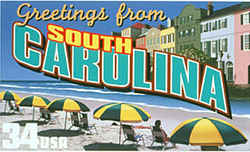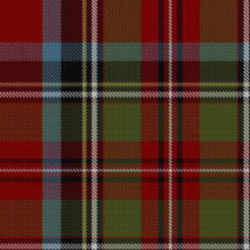
South Carolina Symbols
South Carolina State Tartan
Carolina Tartan

Adopted on June 3, 2002.
The South Carolina State Tartan was adopted on June 3, 2002.
The Carolina Tartan was designed and registered with the Scottish Tartans Society in 1981 by Peter MacDonald of Crieff, Scotland. The design was based on a Royal Stewart tartan believed to have been worn by king Charles I of England during his marriage, giving it significance since The Carolinas were named after King Charles. It was made the official tartan of North Carolina in 1991 when it was passed by the North Carolina General Assembly. South Carolina followed suit and enacted legislation making the Carolina Tartan its official tartan as well in 2002
South Carolina State Tartan: Carolina Tartan
Tartan, a plaid textile design consisting of stripes of varying width and color, was first worn by Scottish Highlanders. Scottish families began to settle in both North and South Carolina in the late 1600s, with Scots eventually becoming a vital part of both colonies. The Carolina Tartan - a variation of a tartan associated with King Charles II - is believed to be the first tartan design sanctioned for a group of US states.
In fact, the "Carolina tartan" shown above (STA No. 1377) is the "official tartan" of the States of North Carolina and South Carolina. It is the only official tartan of these states.
The Carolina tartan was designed in 1981 by Peter MacDonald of Crieff, Scotland. This tartan is the official state tartan of both North and
South Carolina.
Both states have received their fair share of Scottish immigration. The Cape Fear River Valley in particular was home to a large settlement of Gaelic
speaking Highlanders, among them Flora MacDonald. Many of these Highlanders had taken oaths of loyalty to the Crown after the '45 and so fought as
soldiers for the Royalists in the Revolutionary War.
By contrast, the west part of the Carolinas was settled primarily by Ulster Scots, Lowland Scots who had migrated to Ulster in the seventeenth century,
and later to the American colonies. Many of these people would join the fight for American independence in the late eighteenth century. Land grants
given to veterans after the Revolutionary War encouraged many Ulster Scots to settle in the Appalachian mountains of North Carolina.
The Carolina district tartan was the idea of Peter MacDonald. It is based upon a version of the Royal Stewart tartan found in a fragment of a coat
from the Royal Company of Archers c. 1730. It is believed to be the same sett that was used as ribbons on the coat of King Charles II for his marriage
in 1661. It was chosen since the Carolina colonies were named for Charles. MacDonald proposed his idea of a Carolina tartan to the St. Andrews Society
of North Carolina and the St. Andrews Society of Charleston, South Carolina, both of which approved of the idea.
South Carolina Act 303
(A303, R392, H5063)
AN ACT TO AMEND ARTICLE 9, CHAPTER 1 OF TITLE 1, CODE OF LAWS OF SOUTH CAROLINA, 1976, RELATING TO THE OFFICIAL STATE EMBLEMS, BY ADDING SECTION 1-1-703
SO AS TO DESIGNATE THE CAROLINA TARTAN AS THE OFFICIAL TARTAN OF THE STATE OF SOUTH CAROLINA.
Whereas, Scottish families began to settle in both South and North Carolina during the last two decades of the seventeenth century; and
Whereas, in the first half of the eighteenth century, large numbers of both Highland Scots and Ulster Scots settled in the two Carolinas; and
Whereas, Scots became major elements of the population of both colonies; and
Whereas, a tartan is a plaid textile design consisting of stripes of varying width and color, each tartan unique to a clan, district, or group; and
Whereas, St. Andrew's Societies are organizations for the celebration of things Scottish; and
Whereas, St. Andrew's Societies in South and North Carolina arranged for the design of Carolina Tartan and cosponsored the effort for adoption of the
design by the Scottish Tartans Society, which registered the Carolina Tartan in 1981, with the United Kingdom Design Registry; and
Whereas, those St. Andrew's Societies believe that the Carolina Tartan was the first one successfully advanced for a group of states in the United
States, although Canadian provinces have had their distinctive tartans; and
Whereas, since 1981, tartans have been designed for other states; and
Whereas, the Carolina Tartan is a variation of a tartan associated with King Charles II who made the grant of land in 1663 which resulted in the creation
of the Carolina proprietary colony; and
Whereas, there is desire on the part of many South Carolina citizens of Scottish descent to honor their ancestral ties. Now, therefore,
Be it enacted by the General Assembly of the State of South Carolina:
Official state tartan
SECTION 1. The 1976 Code is amended by adding:
"Section 1-1-703. The Carolina Tartan is designated as the official tartan of the State of South Carolina."
Time effective
SECTION 2. This act takes effect upon approval by the Governor.
Ratified the 28th day of May, 2002.
Approved the 3rd day of June, 2002.
South Carolina Law
The law designating the official South Carolina state tartan is found in the South Carolina Code of Laws, Title 1, Chapter 1, Article 9, Section 1-1-703.
Title 1 - Administration of the Government
CHAPTER 1. GENERAL PROVISIONS
ARTICLE 9. STATE EMBLEMS, PLEDGE TO STATE FLAG, OFFICIAL OBSERVANCES
SECTION 1-1-703.
SECTION 1-1-703. Official State tartan.
The Carolina Tartan is designated as the official tartan of the State of South Carolina.
HISTORY: 2002 Act No. 303, Section 1.







